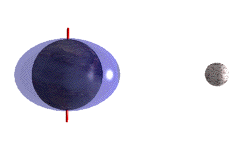
| Home |
| Glossary |
| Lobstering |
| Some Facts |
| Handling Gear |
| Wildlife |
| Tools |
| A Day at Sea |
| The Boat |
| Lobsters |
| Facts |
| Molting |
| Eggers |
| Oversized |
| The Sea |
| About Tides |
| Misc |
| Credits |
| Site Policy |
| The Author |
| Today's Hi/Lo Tides |
10/31/25
00:44 1.066 L
07:05 7.771 H
13:02 1.616 L
19:17 8.511 H
Station: Fort Point, NH
Station-local tide times. Height in Feet (MLLW).
Data are predictions supplied by the NOAA Tidal Predictions
Web Service.
Last updated:
10/31/25 05:59 UTC |
Forces Involved in Making Tides

The gravitational pull of the moon tends to pull water surrounding the earth toward the point closest to the moon while centrifugal forces tend to pull water in the opposite direction. The same is true for the sun, but to a lesser extent. In this illustration the earth, moon, and sun are in alignment resulting in the combined pull of moon and sun acting on the seas. This causes unusually high high tides and unusually low low tides.
It is easier to understand these interactions if we look at them one at a time. For now, consider the earth as a smooth, featureless ball covered with a layer of water.
Rotational
As the earth turns on its axis, it is easy to image a bulge of water developing around the equator due to centrifugal force. This would result in slightly deeper water at the equator and shallower at the poles. Keep in mind that these bulges of water do not appear from nowhere, they are formed by water flowing from other places on the planet.
Orbital
Imagine the earth in orbit (or traveling in a curved path) with no gravitational interaction from the sun. One can then imagine the water being pulled toward the outside of the curve because of centrifugal force (like the pull you feel when cornering in a car). The result is the bulge of water around the equator due to rotation, is now higher on one side than the other. Since the earth is rotating under this bulge, you would get one high and one low tide per day. However, for a body to be traveling in a curved path without any external forces acting on it flies in the face of generally accepted physical laws. For this reason, we must also consider the sun's effect.
Solar
The earth and sun are held in orbit by the balance of centrifugal force generated by the earth's tendency to fly off into space, and the gravitational force exerted by the sun which pulls the earth towards it.
Although these forces are in overall balance, they do not act quite the same way on the earth. Centrifugal force acts uniformly on all points on the earth parallel to a line between the earth and sun, while gravitational forces converge in the center of the sun and so vary with the distance from the sun. Those points closer to the sun will be more affected by the sun's gravitational pull; hence another bulge of water would form on an area of the earth which is closest to the sun.
The result would be two bulges of water, one on the side of the earth nearer to the sun due to the sun's gravitational pull, and the other on the farthest side from the sun due to centrifugal force. Since the earth is rotating under these bulges, a given point on the earth would experience two high and two low tides daily. Moreover, because the earth's axis is tilted the height of the two high and low tides will be slightly different.
Lunar
The moon does not orbit the earth. The earth and moon actually orbit each other with the center of the orbit at a point about 1,100 miles inside the earth. The gravitational pull of the moon affects the water on earth like the sun's pull does. However, although much smaller than the sun, the moon is much closer and ends up exerting about twice as much pull as the sun. The moon, therefore, is considered to exert the largest influence on tidal motion with the sun exerting the second largest influence. Hence, the tides are usually thought of as following the moon even though this cycle is modified somewhat by the sun.
Since tidal periodicity is linked to the moon, and the lunar day is about 24 hours and 50 minutes long, a given high tide will occur about 50 minutes later than the corresponding high tide the day before.